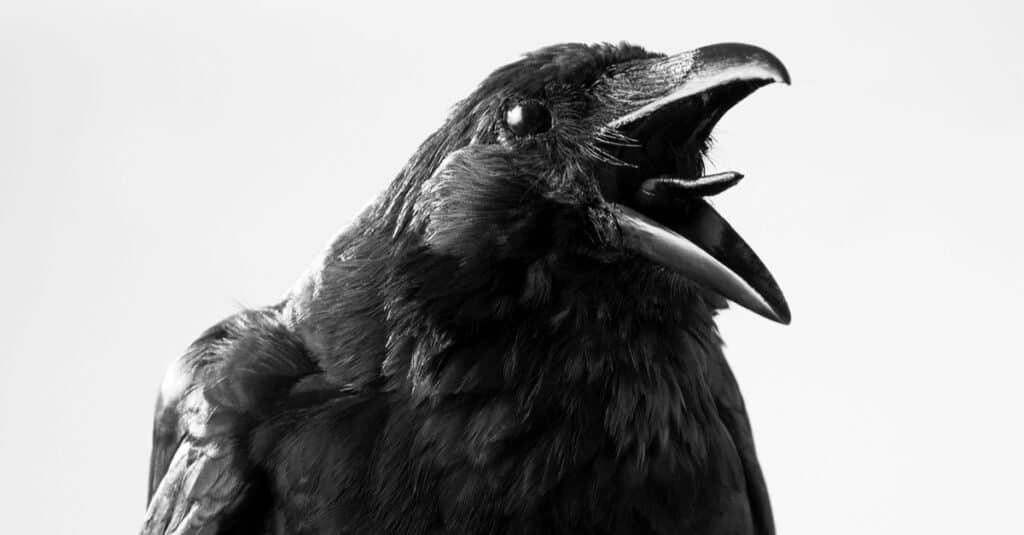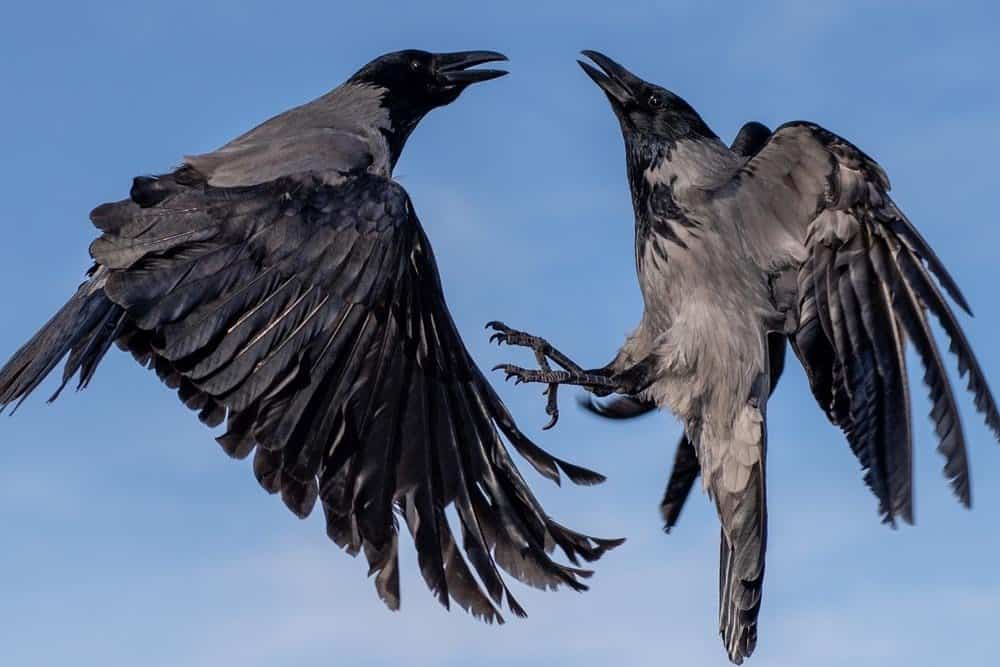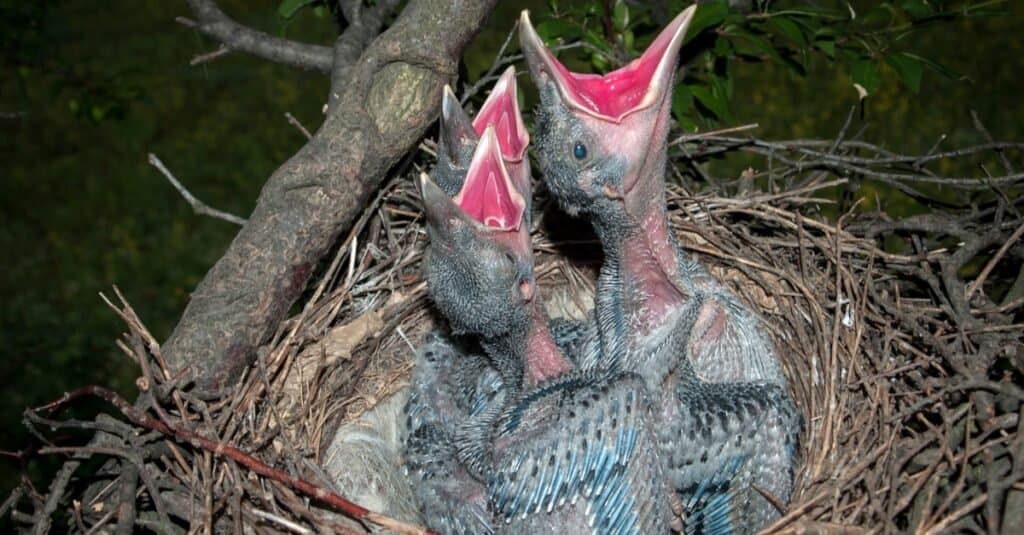Crows are known to be one of the most intelligent and resourceful birds in the animal kingdom and for many good reasons! These brilliant members of the Corvus genus know how to create and use primitive tools made from twigs and rocks, have complex means of communicating with one another, and can even remember where they store food over long periods of time.
There are about 45 different species of crows, ravens, and rooks within the Corvus genus. They exist on every continent except South America and Antarctica. They’re exceedingly clever birds, to be sure, and their unusually high intelligence means they’ve adapted to learn how to hunt and enjoy a varied diet. What do crows eat?
Let’s take an in-depth look at what crows eat, their favorite meals, and the ways in which they find and hunt for food.
15 Foods That Crows Like to Eat

Crows are omnivores, meaning they eat a mixture of plants and animals including seeds, nuts, berries, rodents, snakes, eggs, and small fish. Over 70% of their diet consists of fruits and seeds such as watermelons, grapes, chokecherries, red osier dogwood fruits, bittersweet nightshade berries, watermelon, wheat, corn, oats, poison ivy, pistachios, and pecans. They’re extremely opportunistic and adaptable, which has certainly contributed to their rather long lifespans of around 20 to 30 years on average.
Most crows aren’t too picky and are more than happy to feed on a wide variety of different foods, such as:
- Various seeds and nuts
- Fruits, most commonly berries
- Grains
- Beetles
- Worms
- Garden vegetable crops
- Mice
- Moles
- Mollusks
- Food scavenged from dumpsters and areas where humans congregate
- Lizards
- Small snakes
- Frogs and salamanders
- Eggs
- Small fish
As you can see, crows have learned to make use of just about any food source they manage to come across, which means they are able to quickly adapt to and thrive in a range of rural, suburban, and urban areas.
What to Feed Crows: A Crow’s Favorite Food?

Crows are typically not picky eaters and will ingest just about anything.
©redpip1984/Shutterstock.com
While crows will happily eat just about anything to survive, they do have a few foods they tend to enjoy more than others. If you’ve befriended a crow in your yard recently and want to offer them something they’ll love, consider one of their favorites:
- Nuts, namely peanuts, walnuts, and almonds
- Eggs (raw, boiled, scrambled…it doesn’t matter to a crow!)
- Meat scraps like chicken and fish
- Dry cat and dog kibble/pellet food (yes, really!)
How Do Crows Find Food?

Some crows have learned how to use rudimentary tools to make catching prey and foraging even easier for them
©Vladimir Turkenich/Shutterstock.com
Now we’ve worked out the response to the question, “What do crows like to eat?”, it’s time to examine how these clever avians obtain their food.
Highly intelligent and social, crows tend to hunt and forage in family groups. These family groups usually consist of a breeding pair and their offspring from the past two to three years! They stick together for long periods of time and often work together in surprisingly complex ways to find and capture their various sources of food.
Amazingly, some crows have even learned how to use rudimentary tools to make catching prey and foraging even easier for them! A 2005 study showed how New Caledonian crows commonly use items like modified twigs, rocks, and other items to retrieve and tear into their food. Even juvenile birds were clever enough to quickly pick up on how to use these primitive tools!
This is a pretty incredible discovery, considering very few animals are intelligent enough to understand how to use objects in this way. It’s just another reason why crows are some of the brightest birds around!
Where Do They Live?

Building a nest is done as a couple, sometimes with the help of last year’s chicks.
©Moisieiev Igor/Shutterstock.com
Crows are found in many parts of the world, including Asia, Europe, and North America. They inhabit a wide range of habitats, such as urban areas, farmland, woodlands, grassland savannas, wetlands, and coastal marshes. They tend to prefer open spaces with access to water sources and plenty of trees for nesting materials. Crows can even be seen living near human settlements, where they scavenge leftovers from gardens or garbage cans. As opportunistic feeders, they often take advantage of whatever food is available in their habitat.
Crows build their nests in a wide variety of habitats, including woodlands, fields, urban areas, and wetlands. They prefer to nest in tall trees with dense foliage or on the edges of forests near open areas.
Crows tend to make their nests in a V-shaped area close to the trunk of a tree, usually situated in the upper third or quarter of the tree. They prefer to build nests in conifer and evergreen trees but will settle for other trees if those are not available.
A breeding pair of crows work together to build the nest and usually have assistance from their children from the last season. Apparently, building a cozy nest is a family affair! This nest is usually composed of medium-sized twigs, with the interior being filled with materials such as pine needles, weeds, soft bark, or animal hair. The size of the nest can range quite drastically, usually between 6-20 inches in diameter and up to a foot deep.
Are Crows Good to Have Around?

Crow families can eat up to 40k insects from your garden in one season!
©iStock.com/Nigel Harris
The answer to this question depends on who you ask. Some people find crows to be a nuisance, while others appreciate their presence in the area. Crows are known for being intelligent and vocal birds, so they can be quite loud at times. They can also cause some damage to gardens and crops with their scavenging habits. And they are also smart enough to open trash bins looking for a snack.
On the other hand, crows can be beneficial as they consume a lot of waste each year, which helps to prevent the spread of diseases and bad odors. With their highly efficient digestive systems similar to that of vultures, crows can eat both meat and plants.
Crows tend to favor meat over plants and are often seen near gardens snacking on grubs and bugs rather than fruits and vegetables. Their capacity to take care of pests and parasites from farms is a major advantage when compared to the little damage they cause to the vegetation. A large crow family can consume more than forty thousand grubs, armyworms, and caterpillars during nesting season. Additionally, they help with pollination by transferring pollen from one plant to another. They also consume dead carrion, which hinders the increase of insects.
Crow vs. Raven: What is the Difference?

The difference between a raven and a crow may not seem obvious to the casual observer, but there are distinct differences between them. Both are members of the Corvidae family, which includes crows, ravens, magpies, jays, and more. Ravens tend to be larger than crows, with longer wings and thicker bills. Their tail feathers also have a unique diamond-shaped pattern that is absent in the tails of crows.
In addition to size differences, their calls can be distinguished as well. While both make loud croaks or caws similar to each other, ravens often make higher-pitched chortling sounds, whereas crows typically stay within a lower range of pitches when vocalizing.
Behaviorally speaking, they have a few differences. Ravens are known for being curious and playful animals that engage in activities such as somersaulting mid-flight or playing games with sticks on the ground. Crows, however, usually display less curiosity and playfulness compared to ravens though they do form large flocks for safety purposes when migrating or roosting at night together.
Summary of 15 Foods That Crows Eat
| Food | |
|---|---|
| 1 | Various seeds and nuts |
| 2 | Fruits, most commonly berries |
| 3 | Grains |
| 4 | Beetles |
| 5 | Worms |
| 6 | Garden vegetable crops |
| 7 | Mice |
| 8 | Moles |
| 9 | Mollusks |
| 10 | Food scavenged from dumpsters and areas where humans congregate |
| 11 | Lizards |
| 12 | Small snakes |
| 13 | Frogs and salamanders |
| 14 | Eggs |
| 15 | Small fish |
What Does it Mean When a Crow Visits You?

Crows are highly social birds and often always stay together in family groups. Having one visit you may be a sign that you need to keep in touch with your loved ones.
©Oleg Elkov/Shutterstock.com
There are many things associated with seeing crows or having them visit you. While oftentimes they are thought of as a bad omen, and harbingers of death, there are also positive aspects to this bird’s visit, like a change in your life. Crows can be found just about everywhere, as they live on every continent on Earth except Antarctica. The odds of one visiting you are high.
When a crow is visiting, it is often thought to be a foreshadowing of impending death or doom. However, this can be interpreted in many ways, not just negatively. Death can be interpreted as something ending or changing. You can interpret this in many ways, whether it is the death of one chapter in your life or because something is changing to a different path.
They may also represent communicating, being connected to your family and friends, or even messages. It can be thought that they are trying to tell you that you should pay more attention to these relationships. Next time you receive a visit from a crow, think of what new direction your life may be taking or reach out to a loved one.
The photo featured at the top of this post is © Andre1_ns/Shutterstock.com
Thank you for reading! Have some feedback for us? Contact the AZ Animals editorial team.







